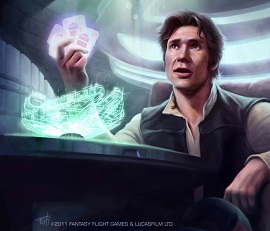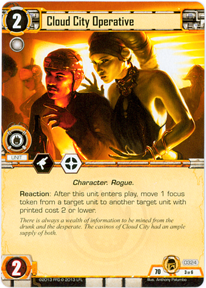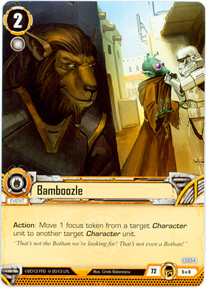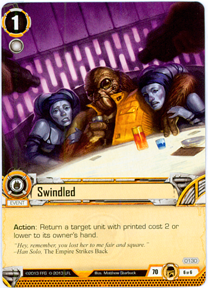Welcome to Card Game DB
Register now to gain access to all of our features. Once registered and logged in, you will be able to create topics, post replies to existing threads, give reputation to your fellow members, get your own private messenger, post status updates, manage your profile and so much more. If you already have an account, login here - otherwise create an account for free today!
Register now to gain access to all of our features. Once registered and logged in, you will be able to create topics, post replies to existing threads, give reputation to your fellow members, get your own private messenger, post status updates, manage your profile and so much more. If you already have an account, login here - otherwise create an account for free today!
Groggy's Guide to Star Wars LCG Episode 3: Board Control
Nov 20 2014 04:00 AM |
GroggyGolem
in Star Wars
Star Wars beginner guide A Long Time Ago In A Galaxy Far, Far Away…
A Long Time Ago In A Galaxy Far, Far Away…Groggy’s Guide to Star Wars LCG Episode 3: Board Control
Swift in defense, the rookie player manages to halt the impending forces coming his way. Determined to endure through the battle, the player now faces a fairly strong board presence from his opponent. His turn begins and he now looks to take control of the game...
Welcome to Groggy’s Guide to Star Wars LCG! This guide is written by a casual player, for casual players. If you’ve just bought your Core Set* or you want to improve in your skills as a player, this guide will aid you in general strategy, deck strategies and more for Star Wars: The Card Game.
*This guide assumes that you have already read and understand the core rules as well as a familiarity with Core Set cards. All cards referenced can be viewed online in the card spoilers section of cardgamedb.com.*
Today we will combine some thoughts and ideas from the previous two articles in this series and talk about the importance of Board Control. More specifically, we will talk about what it is, how to perform it and why it is so important.
So what is Board Control? Board Control is about examining everything in play, (units, enhancements, objectives, the amount of cards in each player’s hand, etc) and making decisions that put control of the game into your hands. It can be described as simply as situational play. Throughout your time playing Star Wars LCG, you might notice certain situations where playing the Mains of your deck might not be advantageous. This could be because there are no protectors available, your opponent has too many units in play or even that you could execute a better turn by using different cards from your hand. Maybe your opponent has a strong board presence setup and you are just getting started. What if your opponent has been dominating the Force Struggle and you need to slow things down? The best option in all cases is to practice Board Control.
How do I perform Board Control? There are many ways to achieve Board Control. It could be as simple as beginning your first engagement with a unit that has Tactics Icons, something like Twi’lek Loyalist or a Twi’lek Smuggler. If your opponent chooses not to defend or loses the edge, you can place a Focus token on whatever unit you don’t want to defend for the next engagement, or simply stop a unit from contributing their Force Icons to the Force Struggle. Sometimes, using board control means you spend a turn or two building up a board presence before declaring engagements.
Other ways of Controlling the Board can be anywhere from destroying enemy units in engagements, using events to damage or destroy units or even prevent units from participating in other engagements. Further means of control come through Keywords like Shielding and Targeted Strike to prevent damage or tactics and destroy units, respectively. The Sith and Smugglers & Spies affiliations excel at Board Control.
For an example, let’s say you have a Wookiee Warrior in play that has 2 Focus Tokens on it. Your opponent has 3 units in play, all three are Ready. All three units are 2 Cost. You have a total of 5 resources this turn. Your hand consists of Cloud City Operative, Lando Calrissian, Target of Opportunity, Bamboozle, Swindledand Saboteur. Your first thought might be to play Lando and attack, using your remaining resource to remove 1 unit from the engagement with Lando’s Action. This could be good, you could remove Lando from the engagement and let the other units focus to strike nothing. What if your opponent doesn’t declare all three of units as defenders though? You might have to fight an edge battle when you would rather keep some of your cards for a later turn.



Rather than attempt to fight that edge battle, why not use different cards from your hand to control the board and strike unopposed? First, play Cloud City Operative and move 1 focus from the Wookiee Warrior to one of your opponent’s units. Then, play Bamboozle to do the same, moving 1 Focus to another unit. Finally, play Swindled on the last remaining Ready unit. Now you have 2 units that are Ready for your Conflict Phase and a Target of Opportunity to further damage your opponent’s objectives. You don’t need to fight an edge battle and you can control the Force Struggle on this turn if you choose to leave one unit ready. On your next turn you’ll be drawing at least 4 new cards as well, so your hand wouldn’t be as clogged as it would have if you had only played Lando.
What about for your defense? Events really come in handy when attempting Board Control. Maybe you are the Light Side player and you are playing a Jedi Mind Trick to Exhaust a Darth Vader who is about to strike or you are the Dark Side player and you are playing Capturedto capture one of your opponent’s Mains. Always pay attention to the unit of your opponent’s that poses the biggest threat to your gameplan. Sometimes, just the presence of certain units can act as a form of Board Control. Chewbacca, for instance, can be an incredibly scary threat to the Dark Side player and participating in engagements will most likely cost the Dark Side player 1 or more untis. Krayt Dragon is a particularly intimidating unit as well with their 5 damage capacity and 4 unit damage icons.
Why is Board Control so important? In Star Wars: The Card Game, you aren’t just trying to get the edge during engagements and win the Force Struggle but you are also trying to control your opponent’s units and actions. Sure, as the Light Side you usually need just 15 Blast Damage to win the game but ignoring what the current board state is can prevent you from even coming close to winning. The same goes for the Dark Side player. Dealing damage to units, Capture, Tactics all aid you in speeding up the game and reaching 12 on the Death Star dial. Use the cards that would best control the board, don’t just play your favorites. Don’t feel rushed when it comes to making decisions. If you need to take a moment to think about your turn, then do so.
Practicing Board Control can give you an advantage for not only your current turn but for future turns as well. It often allows you to Strike unopposed, control the Force Struggle, remove or focus down enemy units, remove enhancements from play, etc. Remember not to engage battles you know you cannot win. Control is a more patient style of play and will certainly require some practice. Using this style of play in combination with the knowledge of good attacking and defending practices, you can take control of your games.
“Control, control, you must learn control!†- Yoda, Star Wars Episode 5: The Empire Strikes Back
Thank you for taking the time to read Groggy’s Guide to Star Wars LCG! Be on the lookout for Episode 4: A Hero’s Deck
Feel free to discuss the article in the comments below!
- WarrenC, Budgernaut, frle88 and 5 others like this



 Sign In
Sign In Create Account
Create Account











7 Comments
Another good article. And I don't know what else to add? At most, remind players that, just like playing the big, fancy units isn't always the best move, focusing on the opponent's mains can sometimes lead to swift defeat. The biggest threat isn't always the one with more damage capacity or combat icons.
Concentrate, evaluate and then execute.
Absolutely this. The mains are not always your most immediate threat, (though they often are). It is really just whatever unit(s) that might prevent you from following through with your strategy.
I love the example you gave. Very nicely done.
Great article and especially useful for the new/upcoming player.
Smuggler Han really is the king of board control. One free damage, targeted strike and a black tactics. Suddenly you've lost two units and another is focused out. It can be difficult to come back from that.
Can I suggest the topic of timing for a future article as I see that as the difference between an average player and a good one. Thinking about when to play events and actions can make all the difference. Simple examples - play rebel assault after refresh to deny your opponent resources or bamboozle units after they have declared in the engagement so you can actually unit damage them (this is not always good though - really depends on if you need to win the edge battle).
Love the concrete example. I would like to second the idea for a timing article. It's my weakest point as a player.
That's actually a great idea. One of the hardest points to master in SWLCG are the action windows, and how to get the best out of each.